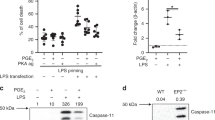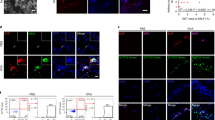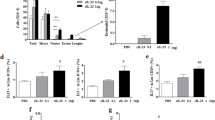Abstract
Extracellular ATP serves as a danger signal to alert the immune system of tissue damage by acting on P2X or P2Y receptors. Here we show that allergen challenge causes acute accumulation of ATP in the airways of asthmatic subjects and mice with experimentally induced asthma. All the cardinal features of asthma, including eosinophilic airway inflammation, Th2 cytokine production and bronchial hyper-reactivity, were abrogated when lung ATP levels were locally neutralized using apyrase or when mice were treated with broad-spectrum P2-receptor antagonists. In addition to these effects of ATP in established inflammation, Th2 sensitization to inhaled antigen was enhanced by endogenous or exogenous ATP. The adjuvant effects of ATP were due to the recruitment and activation of lung myeloid dendritic cells that induced Th2 responses in the mediastinal nodes. Together these data show that purinergic signaling has a key role in allergen-driven lung inflammation that is likely to be amenable to therapeutic intervention.
This is a preview of subscription content, access via your institution
Access options
Subscribe to this journal
Receive 12 print issues and online access
We are sorry, but there is no personal subscription option available for your country.
Buy this article
- Purchase on SpringerLink
- Instant access to full article PDF
Prices may be subject to local taxes which are calculated during checkout






Similar content being viewed by others
References
Wills-Karp, M. Immunologic basis of antigen-induced airway hyperresponsiveness. Annu. Rev. Immunol. 17, 255–281 (1999).
Adriaensen, D. & Timmermans, J.P. Purinergic signalling in the lung: important in asthma and COPD? Curr. Opin. Pharmacol. 4, 207–214 (2004).
Spicuzza, L., Di Maria, G. & Polosa, R. Adenosine in the airways: implications and applications. Eur. J. Pharmacol. 533, 77–88 (2006).
Mohsenin, A. & Blackburn, M.R. Adenosine signaling in asthma and chronic obstructive pulmonary disease. Curr. Opin. Pulm. Med. 12, 54–59 (2006).
van den Berge, M., Polosa, R., Kerstjens, H.A. & Postma, D.S. The role of endogenous and exogenous AMP in asthma and chronic obstructive pulmonary disease. J. Allergy Clin. Immunol. 114, 737–746 (2004).
Burnstock, G. Pathophysiology and therapeutic potential of purinergic signaling. Pharmacol. Rev. 58, 58–86 (2006).
Khakh, B.S. & North, R.A. P2X receptors as cell-surface ATP sensors in health and disease. Nature 442, 527–532 (2006).
Bours, M.J., Swennen, E.L., Di Virgilio, F., Cronstein, B.N. & Dagnelie, P.C. Adenosine 5′-triphosphate and adenosine as endogenous signaling molecules in immunity and inflammation. Pharmacol. Ther. 112, 358–404 (2006).
Ferrari, D. et al. Extracellular ATP triggers IL-1 beta release by activating the purinergic P2Z receptor of human macrophages. J. Immunol. 159, 1451–1458 (1997).
Pelleg, A. & Schulman, E.S. Adenosine 5′-triphosphate axis in obstructive airway diseases. Am. J. Ther. 9, 454–464 (2002).
Idzko, M. et al. Nucleotides induce chemotaxis and actin polymerization in immature but not mature human dendritic cells via activation of pertussis toxin-sensitive P2y receptors. Blood 100, 925–932 (2002).
la Sala, A. et al. Extracellular ATP induces a distorted maturation of dendritic cells and inhibits their capacity to initiate Th1 responses. J. Immunol. 166, 1611–1617 (2001).
la Sala, A. et al. Dendritic cells exposed to extracellular adenosine triphosphate acquire the migratory properties of mature cells and show a reduced capacity to attract type 1 T lymphocytes. Blood 99, 1715–1722 (2002).
Wilkin, F., Stordeur, P., Goldman, M., Boeynaems, J.M. & Robaye, B. Extracellular adenine nucleotides modulate cytokine production by human monocyte-derived dendritic cells: dual effect on IL-12 and stimulation of IL-10. Eur. J. Immunol. 32, 2409–2417 (2002).
Ferrari, D. et al. The P2X7 receptor: a key player in IL-1 processing and release. J. Immunol. 176, 3877–3883 (2006).
Idzko, M. et al. Stimulation of P2 purinergic receptors induces the release of eosinophil cationic protein and interleukin-8 from human eosinophils. Br. J. Pharmacol. 138, 1244–1250 (2003).
Coade, S.B. & Pearson, J.D. Metabolism of adenine nucleotides in human blood. Circ. Res. 65, 531–537 (1989).
Di Virgilio, F. et al. Nucleotide receptors: an emerging family of regulatory molecules in blood cells. Blood 97, 587–600 (2001).
Schnurr, M. et al. Extracellular ATP and TNF-alpha synergize in the activation and maturation of human dendritic cells. J. Immunol. 165, 4704–4709 (2000).
de Heer, H.J. et al. Essential role of lung plasmacytoid dendritic cells in preventing asthmatic reactions to harmless inhaled antigen. J. Exp. Med. 200, 89–98 (2004).
Lambrecht, B.N. et al. Myeloid dendritic cells induce Th2 responses to inhaled antigen, leading to eosinophilic airway inflammation. J. Clin. Invest. 106, 551–559 (2000).
Lambrecht, B.N. & Hammad, H. Taking our breath away: dendritic cells in the pathogenesis of asthma. Nat. Rev. Immunol. 3, 994–1003 (2003).
van Rijt, L.S. et al. In vivo depletion of lung CD11c+ dendritic cells during allergen challenge abrogates the characteristic features of asthma. J. Exp. Med. 201, 981–991 (2005).
Idzko, M. et al. Local application of FTY720 to the lung abrogates experimental asthma by altering dendritic cell function. J. Clin. Invest. 116, 2935–2944 (2006).
Abbracchio, M.P. et al. International Union of Pharmacology LVIII: Update on the P2Y G protein-coupled nucleotide receptors: from molecular mechanisms and pathophysiology to therapy. Pharmacol. Rev. 58, 281–341 (2006).
Vermaelen, K.Y., Carro-Muino, I., Lambrecht, B.N. & Pauwels, R.A. Specific migratory dendritic cells rapidly transport antigen from the airways to the thoracic lymph nodes. J. Exp. Med. 193, 51–60 (2001).
la Sala, A. et al. Alerting and tuning the immune response by extracellular nucleotides. J. Leukoc. Biol. 73, 339–343 (2003).
Beigi, R., Kobatake, E., Aizawa, M. & Dubyak, G.R. Detection of local ATP release from activated platelets using cell surface-attached firefly luciferase. Am. J. Physiol. 276, C267–C278 (1999).
Pitchford, S.C. & Page, C.P. Platelet activation in asthma: integral to the inflammatory response. Clin. Exp. Allergy 36, 399–401 (2006).
Kowal, K., Pampuch, A., Kowal-Bielecka, O., DuBuske, L.M. & Bodzenta-Lukaszyk, A. Platelet activation in allergic asthma patients during allergen challenge with Dermatophagoides pteronyssinus. Clin. Exp. Allergy 36, 426–432 (2006).
Robson, S.C. et al. Loss of ATP diphosphohydrolase activity with endothelial cell activation. J. Exp. Med. 185, 153–163 (1997).
Chen, Y. et al. ATP release guides neutrophil chemotaxis via P2Y2 and A3 receptors. Science 314, 1792–1795 (2006).
Huh, J.C. et al. Bidirectional interactions between antigen-bearing respiratory tract dendritic cells (DCs) and T cells precede the late phase reaction in experimental asthma: DC activation occurs in the airway mucosa but not in the lung parenchyma. J. Exp. Med. 198, 19–30 (2003).
Kohl, J. et al. A regulatory role for the C5a anaphylatoxin in type 2 immunity in asthma. J. Clin. Invest. 116, 783–796 (2006).
Zhou, B. et al. Thymic stromal lymphopoietin as a key initiator of allergic airway inflammation in mice. Nat. Immunol. 6, 1047–1053 (2005).
Harris, N.L., Watt, V., Ronchese, F. & Le Gros, G. Differential T cell function and fate in lymph node and nonlymphoid tissues. J. Exp. Med. 195, 317–326 (2002).
Ferrari, D. et al. Activation of human eosinophils via P2 receptors: novel findings and future perspectives. J. Leukoc. Biol. 79, 7–15 (2006).
Piggott, D.A. et al. MyD88-dependent induction of allergic Th2 responses to intranasal antigen. J. Clin. Invest. 115, 459–467 (2005).
Granstein, R.D. et al. Augmentation of cutaneous immune responses by ATP gamma S: purinergic agonists define a novel class of immunologic adjuvants. J. Immunol. 174, 7725–7731 (2005).
Gallucci, S. & Matzinger, P. Danger signals: SOS to the immune system. Curr. Opin. Immunol. 13, 114–119 (2001).
Di Virgilio, F. Purinergic mechanism in the immune system: a signal of danger for dendritic cells. Purinergic Signal. 1, 205–209 (2005).
Mizumoto, N. et al. CD39 is the dominant Langerhans cell–associated ecto-NTPDase: modulatory roles in inflammation and immune responsiveness. Nat. Med. 8, 358–365 (2002).
Hollander, G.A., Zuklys, S., Forster, E. & Krenger, W. On costimulatory signals and T cell tolerance: relevance for transplantation immunity. Transplant. Proc. 31, 25S–31S (1999).
Laubinger, W., Tulapurkar, M.E., Schafer, R. & Reiser, G. Distinct mono- and dinucleotide-specific P2Y receptors in A549 lung epithelial cells: different control of arachidonic acid release and nitric oxide synthase expression. Eur. J. Pharmacol. 543, 1–7 (2006).
Muller, T. et al. The P2Y14 receptor of airway epithelial cells: coupling to intracellular Ca2+ and IL-8 secretion. Am. J. Respir. Cell Mol. Biol. 33, 601–609 (2005).
Douillet, C.D., Robinson, W.P., III, Milano, P.M., Boucher, R.C. & Rich, P.B. Nucleotides induce IL-6 release from human airway epithelia via P2Y2 and p38 MAPK-dependent pathways. Am. J. Physiol. Lung Cell. Mol. Physiol. 291, L734–L746 (2006).
Mariathasan, S. et al. Cryopyrin activates the inflammasome in response to toxins and ATP. Nature 440, 228–232 (2006).
Ogura, Y., Sutterwala, F.S. & Flavell, R.A. The inflammasome: first line of the immune response to cell stress. Cell 126, 659–662 (2006).
Lommatzsch, M. et al. The course of allergen-induced leukocyte infiltration in human and experimental asthma. J. Allergy Clin. Immunol. 118, 91–97 (2006).
Acknowledgements
This work was supported by an Emmy Noether Fellowship to M.I. from the Deutsche Forschungsgemeinshaft (DFG ID7/3-1) and by a Netherlands Organization for Scientific Research Vidi grant to B.N.L. and Veni grant to H.H. B.N.L. is supported by a European Respiratory Society Romain Pauwels research grant.
Author information
Authors and Affiliations
Contributions
M.I., H.H., D.F., F.D.V., H.C.H. and B.N.L. designed and performed experiments, interpreted and analyzed data, generated figures and wrote the manuscript. M.v.N., M.K., F.M. and M.A.M.W. performed in vitro and in vivo mouse experiments. W.L. and J.C.V. performed and analyzed the human experiments.
Corresponding authors
Ethics declarations
Competing interests
The authors declare no competing financial interests.
Supplementary information
Supplementary Text and Figures
Supplementary Figures 1–4, Supplementary Tables 1–3, Supplementary Methods (PDF 219 kb)
Rights and permissions
About this article
Cite this article
Idzko, M., Hammad, H., van Nimwegen, M. et al. Extracellular ATP triggers and maintains asthmatic airway inflammation by activating dendritic cells. Nat Med 13, 913–919 (2007). https://doi.org/10.1038/nm1617
Received:
Accepted:
Published:
Issue Date:
DOI: https://doi.org/10.1038/nm1617



